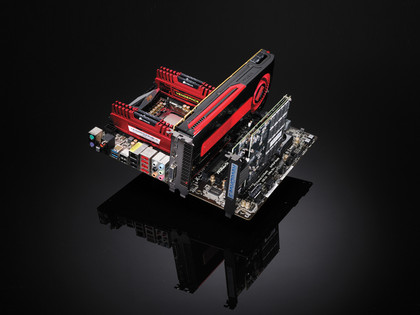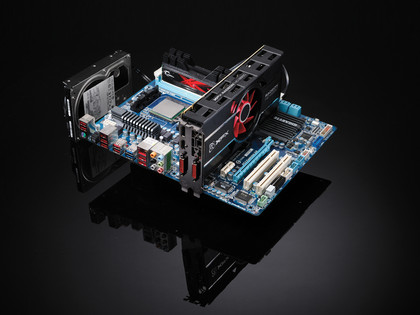Can a £300 gaming PC compare to a £3,000 one?
We pit a cheap gaming PC against a high-end rig
The truth about gaming hardware
Four lab rats, two very different PCs and one astonishing outcome
Setting out on this sort of feature, the outcome is always uncertain. Obviously, we had an inkling that the wallet-pillaging cost of high-end components outweighed the real world performance advantage they bequeath. But £300 versus £3,000? That was really pushing our luck, surely?
What's more, even the best possible result involves a generous helping of humble pie. After all, we've already been harsh on AMD's inability to keep with Intel's CPU performance. If it turns out that £100 worth of previous generation AMD Phenom II chippery can mix it with Intel's latest 32nm, six-core master work, well, let's just say we'll need to do a little in-house recalibration.
With all that in mind, and the results in, the outcome was even more dramatic than we could possibly have imagined. Where, then, to begin this exposition of the unbelievable but undeniable results about PC gaming hardware; this dissertation on the implausible but now proven? Let's start with a quick recap of how we set the test up and who got involved.
The rig-morale

The basic idea is to compare the gaming performance of something affordable with something impossibly exotic in purely subjective terms. It's not about benchmark results; it's about what it feels and looks like to play the game.
In super simple terms, can you tell the difference between the preposterously pricey and the relatively parsimonious? Thus, our real-world rig has an AMD Phenom II X4 960T processor, an AMD Radeon HD 6850 graphics and a 1TB magnetic hard disk courtesy of Hitachi.
Meanwhile, the tippy top system sports Intel's Core i7 3960X, AMD's Radeon HD 7970 and an OCZ RevoDrive 3 X2 480GB solid state drive. Games-wise, Elder Scrolls V: Skyrim, Crysis 2 and DiRT 3 are our on-monitor muses.
Get daily insight, inspiration and deals in your inbox
Sign up for breaking news, reviews, opinion, top tech deals, and more.
While we're on the subject of screens, the 24-inch Philips Brilliance 241P4QPYES (yes, it's a silly name) did the display duties. While it's undoubtedly an awfully nice panel thanks to AMVA LCD technology, its most significant attribute is a 1,920 x 1,080 pixel grid. That's pretty much the default resolution for modern gaming and the setting we chose for both systems.
As for image quality settings, the idea was to max out the eye candy on the high-end rig, to set the bar as high as possible and see if the cheaper, more attainable system - the one most gamers can at least aspire to own - could live with it.
Then we plopped a quartet of gamers with a broad spectrum of experience - from the casual to the professional - in front of our systems and let rip.
No hard feelings

Splitting out the influence of the three major components - CPU, graphics and storage - isn't a trivial job, especially when we're dealing with subjective experiences, not cold, hard numbers. Nevertheless, what we can say is that the issue of storage or hard drive performance is least critical to gaming performance, both subjectively and by the numbers.
In our game-level load tests, the bulk-storage 1TB Hitachi Deskstar was a long way off the pace of OCZ's exotic RevoDrive 3 X2 in percentage terms. In both Skyrim and Crysis 2, OCZ's expensive PCI Express SSD delivers load times roughly twice as rapid as the Deskstar and its portly magnetic platters.
But when you're talking seven seconds versus 15 seconds or 10 versus 20, well, how much does a few seconds really matter? Certainly, none of our test subjects rumbled the true identities of our rigs based on storage performance.
Admittedly, that was partly because the tendency was to obsess over image quality and frame rates once the game had loaded. We also made sure that each test subject's first taste of both systems didn't involve experiencing level loads as we wanted to canvas their unbiased impressions of actual gameplay.
Once they'd experienced that, focussing attentions on level loads was a little tricky. What's more, the biggest performance difference involving storage and games was something none of them got a feel for, namely installation.
The OCZ RevoDrive absolutely tore through game installs using a backup of PC Format's Steam library. The Hitachi Deskstar was a real chore. And that despite the fact that our Steam backup is itself housed on a conventional magnetic hard disk.
It's also true that both our systems were based on fresh installations of Windows 7 and therefore optimal, non-fragmented drive performance. Six months of a routine daily disk abuse would no doubt make the gap big enough to begin to impinge on gaming joy. But then, a fresh reinstall a couple of times a year is a pretty minor inconvenience.
Go go graphics

With storage sidelined, we're left with CPUs and GPUs. Traditionally, we've always put the emphasis on graphics when it comes to gaming grunt. And this experiment has done nothing to change our belief that the surest way to bork your frame rates is a crap graphics card.
Meanwhile, we've long known that the most expensive CPUs are overkill for games. What we didn't anticipate was how little difference a high-end GPU makes. At this point we've little choice but to reveal the overall result.
Most of the time, most of our subjects literally could not tell the difference. In fact, it was worse than that. It wasn't just a case of putting hands up in the air and declaring it a dead heat. Frequently, our testers actually got it the wrong way round, declaring the low-end rig to be rendering with greater fidelity or actually running faster.
We're a courteous bunch, so we'll save blushes by not naming names. However, we will reveal that expectations played a big part in perceptions. Much more so than the background or experience of the tester.
One of our more experienced testers was left almost completely in the dark. All he was told was that we had two setups to compare. We didn't say whether the hardware was different or whether it was just settings. We just asked him to play through a level in each game on both rigs and tell us how they compared.
The result was an intriguing narrative on things that weren't there - differences in lighting, anti-aliasing and texture quality settings that didn't exist. Needless to say, when the truth of the settings and the hardware were revealed, a pair of socks went sailing across the office. That's because the image quality settings on both systems we're very similar indeed.
For Crysis 2 we had to knock a few of the advanced IQ options down a notch. For Skyrim, it was a case of winding anti-aliasing back from 8x to 4x. And for DiRT3 it was even simpler - both systems ran at maximum detail.
The winner

There are plenty of caveats to the result of our experiment, but if you take away anything from this feature, it should be that budget PCs are not the second rate gaming systems they once were. Run a budget rig at the right settings, and you'll produce a quality experience. S
pend your money wisely, and you'll reap the rewards. At the same time, don't be too disparaging of high-end rigs - they definitely have their place. We're thinking particularly when it comes to high-resolution displays.
Technology and cars. Increasingly the twain shall meet. Which is handy, because Jeremy (Twitter) is addicted to both. Long-time tech journalist, former editor of iCar magazine and incumbent car guru for T3 magazine, Jeremy reckons in-car technology is about to go thermonuclear. No, not exploding cars. That would be silly. And dangerous. But rather an explosive period of unprecedented innovation. Enjoy the ride.